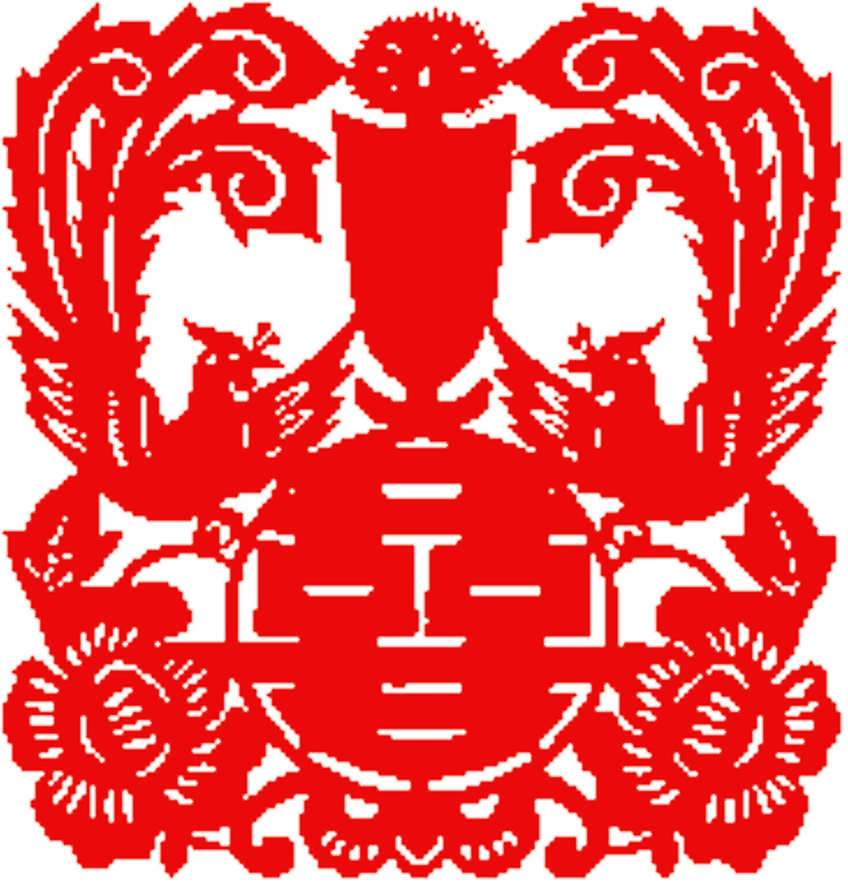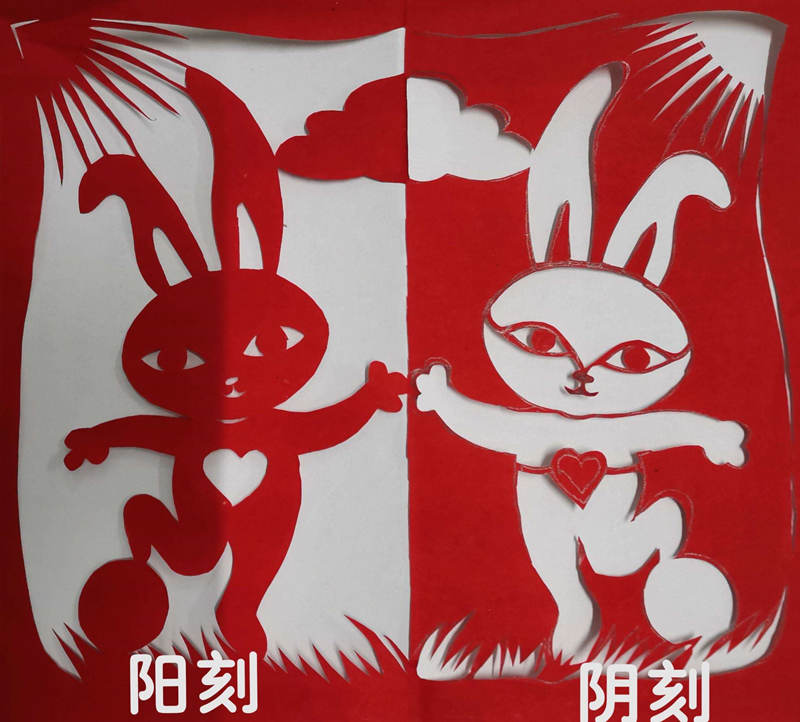Chinese Paper Cutting
Paper cutting art was originated in China. People use scissors or knives to produce decorative patterns out of the paper by cutting and carving. Scholars believed Chinese paper cutting was introduced to the western countries around 16th or 17th century. Nowadays, paper cutting has become a popular activity around the world. In 2009, Chinese paper cutting art was inscribed on the list of the World Intangible Heritage by UNESCO.
Traditionally in the rural areas of China, paper-cut is only done by women. In the past, it could be regarded as a life skill that every girl was supposed to master, and it was also a norm to judge the brides were ingenious or not. Wherever in the north or south of China, this traditional Chinese art form can reflect the aesthetic preference and mindset of Chinese people through a pair of scissors and a piece of paper.

History of Chinese Paper Cutting
During the Stone Age and Bronze Age, Chinese ancestors adopted the certain patterns and pictographs to keep a record of events on tortoise shells, bamboo slips, bronze vessels, hides of animals, etc. Until the eunuch-bureaucrat Cai Lun invented the quality paper for writing and painting in the Eastern Han Dynasty (25-220), it laid the essential foundation of the art form of paper cutting art in China.
Up to now, the earliest paper cut works were found in an ancient tomb of the Northern Dynasties (386-581) in Turpan of Xinjiang. Archaeologists thought the people at that time had achieved a high artistic level in this art form, which means Chinese paper cutting has a history of at least 1500 years. And it might even emerge earlier before the Northern Dynasties.
During the Sui and Tang Dynasties, Chinese paper cut art form became more widespread all over the country. We can find there were the specific lines of poetry describing paper-cutting. At that time the skills and patterns of this art form were also widely applied in different fields. For example, they adopted the same skills of paper-cutting to process the gold or silver foil in order to decorate the back of bronze mirrors for ladies. In Tang Dynasty, certain paper-cutting patterns were also used to communicate with the spirit of the deceased.
In the Song Dynasty, as a popular art form, the paper cutting art began to prosper in China. The related professions and famous masters appeared. The most important application of paper-cutting in Song Dynasty was used for the porcelain patterns. During the process of glazing, the china wares were pasted with paper-cuts on the surface before being fired in the kiln.
In the Ming and Qing Dynasties, the folk art of paper-cutting has reached its peak, which could be widely seen in the life of average people at this time. All the floral decorations on the lanterns, the patterns on the fans and embroidery were all inspired by the art form of paper cuts. The average people also used red-colored paper-cuts to decorate their homes, hoping for the best luck of the family.
The Use of Paper-cut
In the ancient time, paper-cuts were originally used as the ornament of sacrificial offerings honoring the ancestors and supernatural beings. Today, paper-cuts are mainly adopted for interior decoration of the people’s houses. They liven up walls, doors, windows, columns, mirrors, lamps and lanterns. Especially during the wedding ceremonies and Spring Festival, they can surely embellish the settings and enhance the festive vibe. Those bright red paper cuts pasted on the entrances or windows of a house are supposed to bring good luck and keep evil away.
In North China, gift paper-cuts are often seen as decorations on cakes, birthday noodles, eggs and other gifts. In Shandong Province, people attach gift paper-cuts to the symbolic “happy egg” to celebrate a baby’s birth. Paper-cuts themselves are popular presents for friends and family. There are some specific paper-cuts of traditional design used as patterns for embroidering clothes, shoes, hats, pillowcases, curtains and door curtains.
In China, paper-cutting works as an aesthetic form to express people's hopes, gratitude and other emotions. It is rich in content, and usually contains different symbolic meanings. Some express wishes for a harvest or a wealthy life, shown through the imagery of a golden harvest, thriving domestic animals and plants, as well as good fortunes, while a carp jumping over a dragon gate (a traditional Chinese story) indicates a leap towards a better life. The design of lotus flowers (sometimes with seedpod) and bottle gourd suggest a happy big family with many children and grandchildren. Tortoise-patterned paper-cuts symbolize longevity, which are commonly seen in the countryside of Fujian Province. You can also see the various images of lions, Kylins (a mythical Chinese creature), rabbits, bats, fish, birds, pomegranates and peonies on the traditional paper-cuts.
The two Chinese characters 福 fú (meaning 'lucky') and 囍 xǐ (meaning 'double happiness') are the most frequently used ones in Chinese paper cutting, which are often seen on the doors or windows of Chinese homes. 福 is usually used during the Chinese New Year's Festival, demonstrating the people's good wishes for a lucky year. 囍 can always be seen during the Chinese weddings.
Chinese Paper Cutting Classification
Roughly speaking, there are mainly seven main schools in terms of the regions with deep-rooted cultural background of Chinese paper-cutting.
1. Yuxian paper-cut of Hebei
The style of paper-cutting was born in Yuxian County, Hebei Province. It is a kind of colorful paper-cuts made of paper material with good water absorption, and then painted with a brush. Its main feature is colored dot painting on their works, which is unique in the Chinese paper-cutting circle. In addition, the folk paper-cutting here is the only one in the country that is mainly engraved negatively, while most of others are of positive engraving in the country. Besides, the traditional paper-cuts are made in sets. The biggest set contains as many as twenty-four chapters, and each chapter has 4 pieces of paper-cutting work!

2. Guangling paper-cut in Shanxi
The Chinese paper cutting in Guangling area of Shanxi originated in the early Tang Dynasty, matured in the Ming Dynasty, and prospered in the late Qing Dynasty. It integrates the styles of North China and East China (Jiangsu and Zhejiang), which stands out in its own way with its bright colors, various patterns, slender lines, vivid expressiveness and delicate knife skills. Instead of scissors, the local artisans in Guangling use knives (chisels) to engrave on rice paper for the cutting process, and paint with colored inks.
3. Chinese Paper Cutting in Shandong
It is believed that the paper-cuts in Shandong originated in the Tang Dynasty, and matured in the Ming and Qing Dynasties. Folk paper-cuts in Shandong vary from place to place, and can be roughly divided into the rugged, bold, concise style in the Bohai Bay area and the delicate, exquisite style in the coastal area of Jiaodong. The themes mainly involve animals and flowers, which are used to attach to the windows for decoration. In the rural area of Jiaodong region, the bride's ingenuity can be judged according to the window paper cuts done by the bride in old days. Therefore, girls had to learn paper-cutting skills before marriage as seriously as stitching and embroidery.
4. Paper-cut in Shaanxi
The paper-cuts of Shaanxi are called "living fossils" by many Chinese scholars. From south to north, we can see this art form prospers all over the province, which occupies an important position in the folk arts of China. The themes of paper-cuts include not only ancient myths, legends, and folk beliefs, but also the representation of modern rural folk life and daily farm work, with full of profound cultural connotations and strong local features. Among the folk paper-cuts in Shaanxi, the works from northern Shaanxi are thought to be the best, which fully respect the traditions, with a concise style and rich techniques.
5. Paper-cut in Jiangsu and Zhejiang
Generally speaking, folk paper-cuts in Jiangsu and Zhejiang are different in style, they are all more delicate and exquisite, the lines are smooth and bright, and the content is also dominated by flowers and plants.
The folk paper-cut of Yangzhou is representative in Jiangsu area, which originated in the Sui Dynasty, and matured in the Ming and Qing Dynasties. Yangzhou paper-cutting is characterized by exquisite workmanship and subtle delineation. When a paper-cut work lying on the table, it looks like the clusters of paper threads. While if you pick it up, you will see it is an amazing intact artwork.
The folk paper-cut of Zhejiang originated in the Tang Dynasty. During the Ming and Qing Dynasties, it reached its heyday. Due to the different tools of scissors and carving knives used by the artists in different parts of Zhejiang, their woks have also formed different characteristics. The paper-cut works with the themes of opera stories are unique. The composition of the work is more complicated with vivid shapes.
6 .Chinese Paper Cutting in Fujiang
The folk paper-cut of Fujian is a gem in the coastal area of Southeastern China. Paper-cuts in all parts of Fujian also have different characteristics. In the mountainous areas of Nanping, Hua'an and other places, there are many works that mainly depict the poultry and livestock; in the coastal areas like Zhangpu region, the works are featured with aquatic animals; in Putian and Xianyou, flowers are often seen in their works.
7. Chinese Paper Cutting in Guangdong
Guangdong folk paper-cuts are famous at home and abroad for their superb skills and unique styles, especially those in Foshan and Chaozhou. The difference between Guangdong folk paper-cutting and paper-cutting in other areas is that the main material is not paper, but gold, silver, copper or tin foil.
Foshan folk paper cutting have strong colors, and adopt the techniques of cutting, carving and chiseling. The artisans of Foshan folk paper-cuts not only respect the traditions, characterized by rigorous composition, strong decoration, but also implement innovations in the contents and skills, which keep the old art form further advance in the new era. The style of Chaozhou paper-cut is closely related to folk cultural life. Its themes include various opera characters, as well as decorative ones serving traditional festivals and weddings.
With our China Educational Student/Youth Tours, students, teenagers and youngsters can learn how to do Chinese paper cutting. Never miss it!
Related Reading